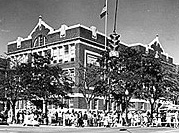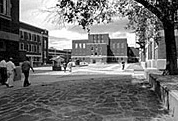Old Albuquerque High
Would You Live in a High School?
Google Street View
312 Central Ave NE, Albuquerque, NM 87102
By Audriana McManus
School buildings may not seem like the biggest historical landmark in a city; however, they have probably seen the most life and changes through the years. When Albuquerque was established, school was not the most important thing on the agenda. Though when the city began to grow larger and larger and more saloons established themselves on the street that would eventually be called Central, Albuquerque High was created.

ABQ High Front
How Old Albuquerque High Came to Be
The first building Albuquerque High occupied was not the same as what we today know as Old Albuquerque High. In fact, it was not the second, nor the third building. As the city grew and changed, the high school was constantly being moved from one building to another. Eventually, around the sixth move, the city decided that a permanent building should be built for their 12,000 residents, and in 1914 the 7th location opened its doors. 1 Critiques of the project thought that the first building built, which would come to be called “Old Main,” was too big and would never be able to reach its capacity of 500 students. The city grew so much that just 13 years later, a second building was built and by 1940, there were five total. Albuquerque high remained the only high school until 1949.2
The area around the school was also in constant flux. One of the buildings, the Gymnasium, sat right next to an arroyo, which became a place for many social events. For example, the Albuquerque High school website mentions that:
The arroyo which ran along the north side was quite deep and it often was the ground used for settling disputes. In 1915, it was the meeting place of two rival gangs, the Capulets and the Montagues; and in 1917 the rival gangs who used the area were the Hatfields and the McCoys.
The other buildings included the Manual Arts Building which was built in 1927, the Classroom Administration Building built in 1937, and the Library Building, the final structure, in 1940.3 Around these buildings Albuquerque continued to grow, pushing further and further out from Central.
Architecture

ABQ High Courtyard
Before the idea of Albuquerque High came about, the city had to be planned. With the coming of the railroad, actual roads were needed in new Albuquerque. Colonel Marmon was assigned to lay out main city streets. One of the first streets he laid ran parallel to the horse car line. This street was named Central. Marmon also plotted streets that the railroad did not request. The widest street in Albuquerque, which he named Broadway, was the start of four more streets east of it. The first street was Arno, named after Arno Huning who was a businessman in Albuquerque. Two of the streets were named after his own children, Edith and Walter, and the last street was called High.4
When the first building was commissioned, it was created by an El Paso architect Henry C. Trost who designed it to face Central. Old Main was designed in the Gothic Revival style, which was mimicked by the next four buildings. The second building, the Manual Arts Building, was designed by local artist Gorge Williamson in 1927 on Arno Street. Another local architect, Louis Hesselden, was commissioned to create the last three buildings, due to New Deal funding and WPA manpower.5
What is it Now?
The Lofts at Albuquerque
The school was unable to keep up with new health codes and began to fall apart. A new Albuquerque High was built only about a mile away, and Old Albuquerque was closed in 1974. The building was eventually marked as a “blighted area” by City Council and was scheduled to be bulldozed and turned into a parking lot. The Albuquerque High School Alumni Association, created in 1994, became the leaders in helping to preserve the old school.6 Eventually, the developer Dekker, Perich, & Sabatini was brought on to convert the campus to office space and loft apartments.7 The project was completed in 20028 and was so successful that the city decided to draft a master plan in 2005 to guide further revitalization to the surrounding areas of the East Downtown District9. As the school was considered a historic building at this point, the school walls, chalkboards, floors, and ceilings were preserved.
Due to the success of Old Albuquerque’s revitalization, many other buildings on central were encouraged to fix up as well. The city encouraged historic Albuquerque to become a “park once” place and a “pedestrian first” place where everything should be within walking distance.10

The Lofts at Albuquerque High
Beautiful place to stop and Appreciate
The Old Albuquerque High, or as the business is called, The Lofts at Albuquerque High, is a stunning piece of architecture that blends history with functionality. If visiting Albuquerque and cruising down Central, it is a gorgeous place to wander around in as long as you don’t disturb the residents. The history of this campus is rich and so many people are proud what it was and what it has become. It should be on everyone’s list to at least pass by.
Sources
-
Albuquerque High School. Albuquerque High Yearbook excerpt ahs-aps-nm.schoolloop.com [n.d.]. ↩
-
Albuquerque High School. Albuquerque High Yearbook excerpt ahs-aps-nm.schoolloop.com [n.d.]. ↩
-
National Register of Historic Places Multiple Property Documentation Form. NM Historic Preservation nmhistoricpreservation.org [2009]. ↩
-
Albuquerque High School. Albuquerque High Yearbook excerpt ahs-aps-nm.schoolloop.com [n.d.]. ↩
-
Albuquerque High School. Albuquerque High Yearbook excerpt ahs-aps-nm.schoolloop.com [n.d.]. ↩
-
Albuquerque High School Alumni Association. Albuquerque High School Alumni ahsalumniassoc.com [n.d.] ↩
-
Old Albuquerque High Lofts. DPS Designs dpsdesigns.org [n.d.] ↩
-
Cantera Consultants and Advisors, Inc. Project file for Lofts at ABQ High canteraconsultants.com [n.d.] ↩
-
Olsen, Eric, et. all. Sierra Club sierraclub.org [2005] ↩
-
City of Albuquerque Planning Department Downtown Action Team. Downtown2025 cabq.gov [2014] ↩